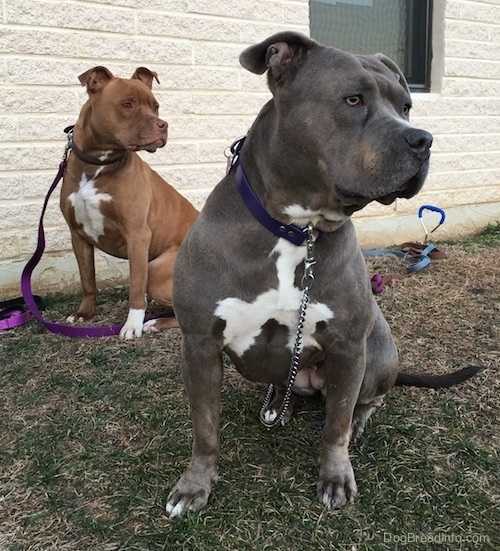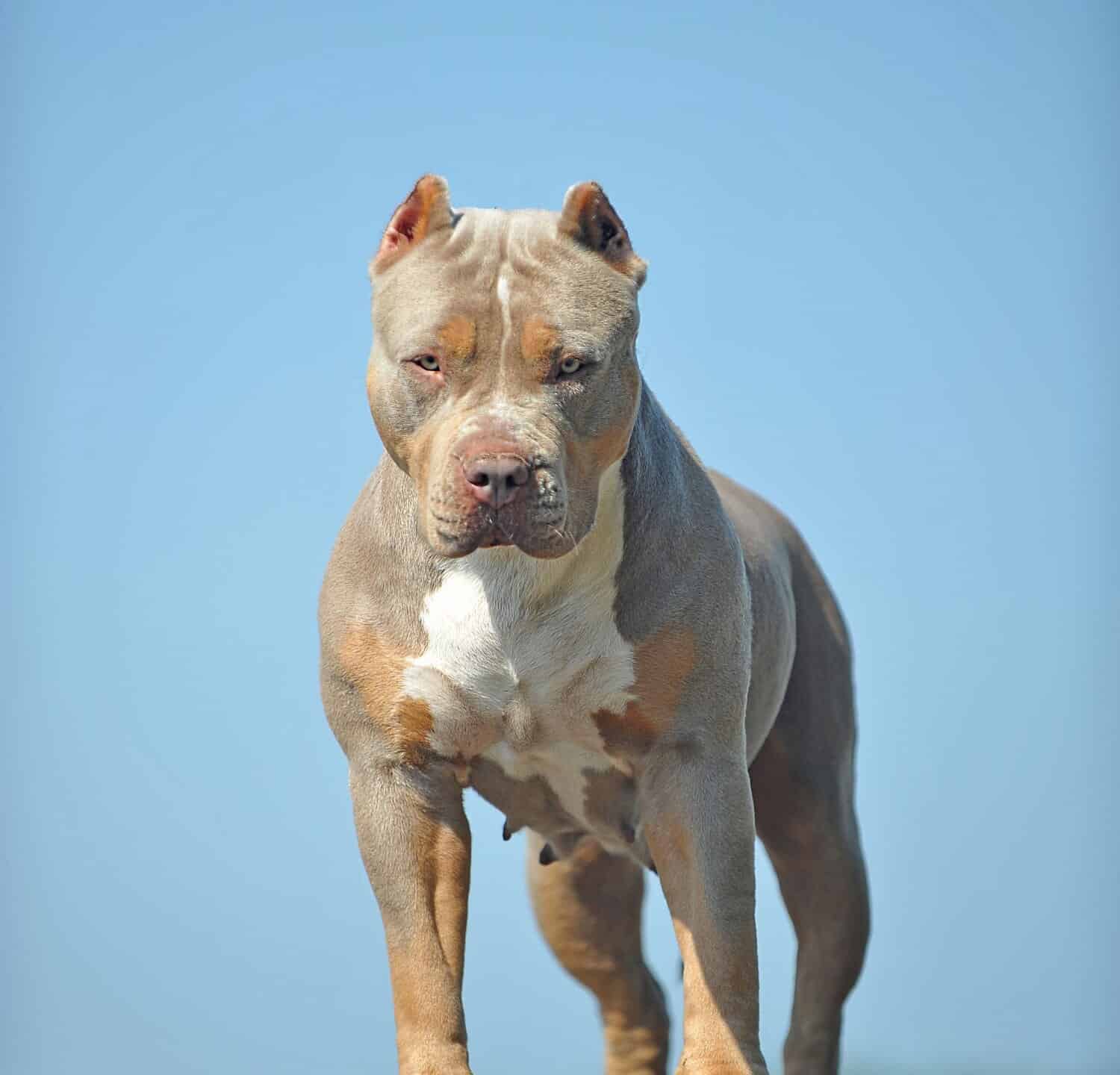Are you ready to be amazed? Pitbull terriers, despite their fierce reputation, actually have the potential to become quite large. These muscular and powerful dogs are known for their impressive build and size. So, if you’re looking for a strong and substantial canine companion, a pitbull terrier might just be the perfect fit.
Pitbull terriers have a fascinating history that contributes to their potential size. Bred for bear and bull-baiting in the past, these dogs were selectively bred for their strength and agility. This breeding history, coupled with their genetic characteristics, can result in pitbull terriers reaching an average weight of 30 to 60 pounds. However, it is important to note that proper nutrition, exercise, and care play a significant role in determining a pitbull terrier’s ultimate size. With the right attention and a balanced lifestyle, your pitbull terrier can grow into a loyal, robust, and impressive companion.

Do Pitbull Terriers Get Big?
When it comes to Pitbull Terriers, one of the most common questions people have is whether or not they get big. Pitbulls are known for their muscular build and strong appearance, but their size can vary depending on various factors. In this article, we will explore the different factors that contribute to a Pitbull’s size and provide you with a comprehensive understanding of how big they can actually get.
Factors That Influence Pitbull Terrier’s Size
There are several factors that influence the size of a Pitbull Terrier. Let’s take a closer look at each of these factors:
1. Genetics
The genetics of a Pitbull play a significant role in determining its size. Pitbull Terriers are a mixed breed, and their size can be influenced by the different breeds that make up their genetic makeup. For example, if a Pitbull has genes from a larger breed such as the Staffordshire Bull Terrier, American Bulldog, or Mastiff, they are more likely to be bigger in size. On the other hand, if their genetic makeup leans towards smaller breeds like the Boston Terrier or Rat Terrier, they may be smaller in size.
In addition to breed genetics, the size of the individual Pitbull’s parents also plays a role. If their parents were on the larger side, it is more likely that the Pitbull will also grow to be bigger.
2. Nutrition and Exercise
Nutrition and exercise are crucial factors that impact a Pitbull’s growth and size. Providing a balanced and nutritious diet is essential for ensuring proper growth and development. A Pitbull that receives a high-quality diet with the right balance of proteins, fats, and carbohydrates is more likely to reach their full size potential. On the other hand, inadequate nutrition can result in stunted growth or smaller size.
Along with nutrition, regular exercise is vital for a Pitbull’s development. Physical activity helps build their muscles and promotes healthy growth. By engaging in activities like walks, runs, and playtime, Pitbull Terriers can maintain a healthy weight and achieve their full size potential.
3. Gender
The gender of a Pitbull can also influence its size. In general, male Pitbulls tend to be larger and heavier than females. Males often have a more robust bone structure and muscular build, contributing to their larger size. However, it’s important to note that individual variations within the breed can also result in smaller male Pitbulls or larger female Pitbulls.
4. Age
Age is another crucial factor to consider when evaluating a Pitbull’s size. Like any other breed, Pitbull Terriers go through different growth stages. They are generally considered fully grown around the age of two years. During this period, they experience significant growth in height and weight. It’s important to provide them with proper nutrition and care during their growth stages to ensure they reach their full size potential.
5. Health
The overall health of a Pitbull can also impact its size. If a Pitbull is suffering from health conditions or malnutrition, it can affect their growth and prevent them from reaching their full size potential. Regular visits to the veterinarian, proper vaccinations, and a healthy lifestyle are crucial for ensuring a Pitbull’s well-being and growth.
6. Neutering/Spaying
Finally, whether or not a Pitbull has been neutered or spayed can also affect their size. Some studies suggest that spaying or neutering a Pitbull at a young age can result in slightly smaller sizes. This may be because the removal of reproductive hormones can influence their growth.
It’s important to note that while these factors influence a Pitbull’s size, there is no guarantee of how big or small an individual Pitbull will be. Each dog is unique and may vary in size, even within the same litter. It’s essential to provide them with proper care, nutrition, and a loving environment to ensure their overall well-being, regardless of their size.
Pitbull Size Expectations
Now that we understand the factors that impact the size of Pitbull Terriers, let’s discuss the typical size expectations for this breed:
1. Height
On average, Pitbull Terriers stand between 17 to 20 inches tall at the shoulder. However, some Pitbulls can be shorter or taller depending on their genetic makeup and other factors.
2. Weight
Pitbull Terriers typically weigh between 30 to 60 pounds. Male Pitbulls tend to be on the heavier side, ranging from 35 to 60 pounds, while females generally weigh between 30 to 50 pounds. However, it’s important to remember that these are average weights, and individual Pitbulls may vary in size.
3. Comparison to Other Breeds
When comparing Pitbull Terriers to other breeds, they generally fall in the medium-sized category. They are smaller than large breeds like Great Danes or St. Bernards but larger than smaller breeds like Chihuahuas or Pomeranians.
Tips for Raising a Pitbull Terrier
Raising a Pitbull Terrier to reach their full potential requires proper care and attention. Here are some tips to ensure their healthy growth:
1. Provide a Balanced Diet
Offer a high-quality dog food that meets their nutritional needs. Consult with a veterinarian to determine the best diet for your individual Pitbull based on their age, size, and activity level.
2. Implement Regular Exercise Routine
Engage them in regular exercise to promote muscle development and maintain a healthy weight. Activities such as brisk walks, games of fetch, and interactive play sessions are excellent ways to keep them active.
3. Schedule Regular Vet Check-ups
Bring your Pitbull to the veterinarian for routine check-ups, vaccinations, and preventive care. Regular visits to the vet will ensure any health issues are addressed promptly and contribute to their overall well-being.
4. Socialize and Train
Pitbull Terriers are social dogs that thrive on interaction with their owners and other animals. Socialize them from a young age and provide proper training to ensure they grow up to be well-behaved and happy pets.
5. Provide Mental Stimulation
Engage them in mentally stimulating activities such as puzzle toys, obedience training, or interactive games. Keeping them mentally engaged prevents boredom and promotes overall well-being.
Conclusion
Pitbull Terriers can indeed grow to be big, but their size depends on various factors such as genetics, nutrition, exercise, gender, age, health, and whether or not they have been neutered or spayed. While there are average height and weight expectations for the breed, individual Pitbulls can vary in size. The key to raising a healthy Pitbull is to provide them with proper care, nutrition, and a loving environment. By doing so, you can ensure they reach their full potential, regardless of their size. Remember, what matters most is their well-being and the bond you build with them.
Key Takeaways: Do Pitbull Terriers Get Big?
- Pitbull terriers can grow to be quite large in size.
- On average, male pitbull terriers tend to be larger than females.
- Nutrition and exercise play a role in the growth and size of pitbull terriers.
- Genetics also influence how big a pitbull terrier can get.
- It’s important to provide proper care and healthy habits to support a pitbull terrier’s growth.
Frequently Asked Questions
If you’ve ever wondered about the size of Pitbull Terriers, here are some common questions and answers that might help:
1. Are Pitbull Terriers naturally big dogs?
Pitbull Terriers are a medium-sized dog breed, so they are not considered naturally big like some giant breeds. However, they do have a muscular build and can be quite strong and sturdy.
While individual sizes may vary, male Pitbulls typically range between 17 to 21 inches (43 to 53 cm) in height at the shoulder and weigh around 35 to 60 pounds (16 to 27 kg). Female Pitbulls are usually slightly smaller, measuring around 16 to 20 inches (40 to 50 cm) in height and weighing between 30 to 50 pounds (14 to 23 kg).
2. Do Pitbull Terriers gain a lot of weight as they grow?
Like all dogs, Pitbull Terriers will naturally gain weight as they grow, especially during puppyhood. However, it is important to ensure they maintain a healthy weight to avoid obesity-related health issues.
Feeding your Pitbull a balanced diet and providing regular exercise is crucial for their overall well-being. Monitor their weight regularly and consult with a vet to determine the appropriate feeding portions and exercise routine to keep them in good shape.
3. Can Pitbull Terriers become larger than average?
While Pitbull Terriers generally fall within a standard size range, individual dogs can vary. Some may end up on the smaller side of the spectrum, while others may grow a bit larger than average. Factors such as genetics, lineage, and overall health can influence their final size.
If you have concerns about the size of your Pitbull Terrier, consult with a reputable breeder or a veterinarian. They can provide guidance specific to your dog and help you understand what to expect based on their lineage and growth patterns.
4. At what age do Pitbull Terriers stop growing?
The growth rate and when Pitbull Terriers stop growing can vary from dog to dog. In general, Pitbulls reach their full height between 12 to 18 months. However, they may continue to fill out and gain muscle mass until they are around two to three years old.
Keep in mind that each dog is unique, and their growth pattern may differ. Proper nutrition, exercise, and keeping up with regular vet check-ups will ensure their growth is on track and healthy.
5. How can I help my Pitbull Terrier reach their maximum size potential?
Achieving a Pitbull Terrier’s maximum size potential is not solely about making them bigger but ensuring they have proper nourishment, exercise, and veterinary care for optimal growth and overall well-being.
Provide a balanced and nutritious diet, engage in regular exercise, and ensure routine vet check-ups. A healthy lifestyle will help them reach their genetic size potential and maintain a strong, muscular build that Pitbull Terriers are known for.

American Pitbull Terriers 101
Summary
So, let’s quickly recap what we’ve learned about pitbull terriers and their size. Pitbull terriers can grow to be quite big, but their size can vary depending on factors like genetics and how they’re taken care of. Some can be as small as 30 pounds, while others can weigh over 70 pounds. It’s important to remember that each pitbull terrier is unique and may not fit the standard size expectations. Proper nutrition, exercise, and love from their owners are essential for their growth and overall well-being.
